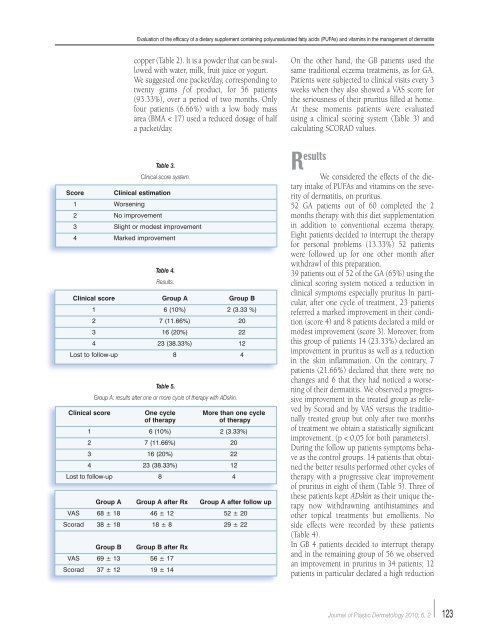Cop ISPLAD - Salute per tutti
Cop ISPLAD - Salute per tutti
Cop ISPLAD - Salute per tutti
You also want an ePaper? Increase the reach of your titles
YUMPU automatically turns print PDFs into web optimized ePapers that Google loves.
Evaluation of the efficacy of a dietary supplement containing polyunsaturated fatty acids (PUFAs) and vitamins in the management of dermatitis<br />
cop<strong>per</strong> (Table 2). It is a powder that can be swallowed<br />
with water, milk, fruit juice or yogurt.<br />
We suggested one packet/day, corresponding to<br />
twenty grams ƒof product, for 56 patients<br />
(93.33%), over a <strong>per</strong>iod of two months. Only<br />
four patients (6.66%) with a low body mass<br />
area (BMA < 17) used a reduced dosage of half<br />
a packet/day.<br />
Table 3.<br />
Clinical score system.<br />
Score Clinical estimation<br />
1 Worsening<br />
2 No improvement<br />
3 Slight or modest improvement<br />
4 Marked improvement<br />
Table 4.<br />
Results.<br />
Clinical score Group A Group B<br />
1 6 (10%) 2 (3.33 %)<br />
2 7 (11.66%) 20<br />
3 16 (20%) 22<br />
4 23 (38.33%) 12<br />
Lost to follow-up 8 4<br />
Table 5.<br />
Group A: results after one or more cycle of therapy with ADskin.<br />
Clinical score One cycle More than one cycle<br />
of therapy of therapy<br />
1 6 (10%) 2 (3.33%)<br />
2 7 (11.66%) 20<br />
3 16 (20%) 22<br />
4 23 (38.33%) 12<br />
Lost to follow-up 8 4<br />
Group A Group A after Rx Group A after follow up<br />
VAS 68 ± 18 46 ± 12 52 ± 20<br />
Scorad 38 ± 18 18 ± 8 29 ± 22<br />
Group B Group B after Rx<br />
VAS 69 ± 13 56 ± 17<br />
Scorad 37 ± 12 19 ± 14<br />
On the other hand, the GB patients used the<br />
same traditional eczema treatments, as for GA.<br />
Patients were subjected to clinical visits every 3<br />
weeks when they also showed a VAS score for<br />
the seriousness of their pruritus filled at home.<br />
At these moments patients were evaluated<br />
using a clinical scoring system (Table 3) and<br />
calculating SCORAD values.<br />
r esults<br />
We considered the effects of the dietary<br />
intake of PUFAs and vitamins on the severity<br />
of dermatitis, on pruritus.<br />
52 GA patients out of 60 completed the 2<br />
months therapy with this diet supplementation<br />
in addition to conventional eczema therapy.<br />
Eight patients decided to interrupt the therapy<br />
for <strong>per</strong>sonal problems (13.33%) 52 patients<br />
were followed up for one other month after<br />
withdrawl of this preparation.<br />
39 patients out of 52 of the GA (65%) using the<br />
clinical scoring system noticed a reduction in<br />
clinical symptoms especially pruritus In particular,<br />
after one cycle of treatment, 23 patients<br />
referred a marked improvement in their condition<br />
(score 4) and 8 patients declared a mild or<br />
modest improvement (score 3). Moreover, from<br />
this group of patients 14 (23.33%) declared an<br />
improvement in pruritus as well as a reduction<br />
in the skin inflammation. On the contrary, 7<br />
patients (21.66%) declared that there were no<br />
changes and 6 that they had noticed a worsening<br />
of their dermatitis. We observed a progressive<br />
improvement in the treated group as relieved<br />
by Scorad and by VAS versus the traditionally<br />
treated group but only after two months<br />
of treatment we obtain a statistically significant<br />
improvement. (p < 0,05 for both parameters).<br />
During the follow up patients symptoms behave<br />
as the control groups. 14 patients that obtained<br />
the better results <strong>per</strong>formed other cycles of<br />
therapy with a progressive clear improvement<br />
of pruritus in eight of them (Table 5). Three of<br />
these patients kept ADskin as their unique therapy<br />
now withdrawning antihistamines and<br />
other topical treatments but emollients. No<br />
side effects were recorded by these patients<br />
(Table 4).<br />
In GB 4 patients decided to interrupt therapy<br />
and in the remaining group of 56 we observed<br />
an improvement in pruritus in 34 patients; 12<br />
patients in particular declared a high reduction<br />
Journal of Plastic Dermatology 2010; 6, 2 123

















